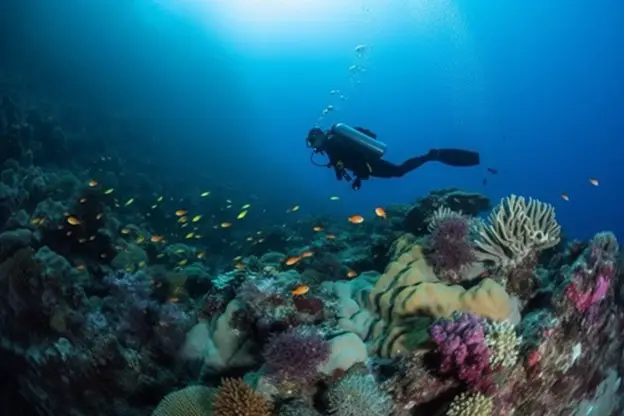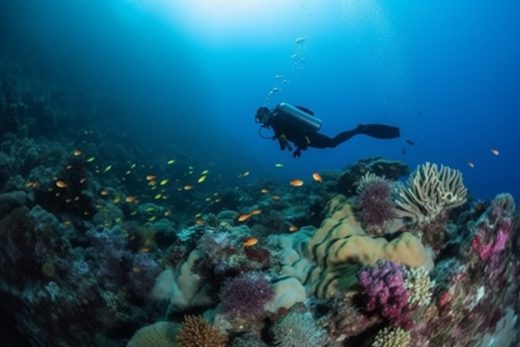Bali scuba diving underwater guide, Southeast Asia dive options, Coral Triangle marine life, Holiday adventure
Bali Scuba Diving Underwater Wonderland
13 June 2023
A Comprehensive Guide to Scuba Diving in Bali’s Underwater Wonderland
Bali, the picturesque island in Indonesia, is not only renowned for its stunning landscapes and vibrant culture but also as a scuba diving paradise. Scuba diving Bali is a gateway to the mesmerizing world beneath the waves. As part of the Coral Triangle, a region renowned for its incredible marine biodiversity, Bali boasts an astounding array of underwater flora and fauna. In this comprehensive guide, we will explore the allure of scuba diving in Bali, from its geographical location and climate to its renowned diving regions and highlights. Whether you’re a beginner or an experienced diver, Bali promises unforgettable underwater adventures.
Geographical location and climate
Situated in the Indonesian archipelago, Bali is bordered by the Indian Ocean to the south and the Bali Sea to the north. Its tropical climate ensures warm temperatures year-round, with average air temperatures ranging from 26 to 32 degrees Celsius (79 to 90 degrees Fahrenheit). The dry season, which runs from April to October, is the ideal time for diving, as the visibility is at its best and the sea conditions are generally calmer.
Marine biodiversity and dive conditions
Bali is part of the Coral Triangle, an area recognized as the most biodiverse marine ecosystem on Earth. Its waters teem with a wide array of marine life, including vibrant coral reefs, tropical fish, turtles, sharks, and manta rays. The visibility in Bali’s dive sites varies but is generally good, ranging from 15 to 40 meters (50 to 130 feet). Water temperatures range from 26 to 29 degrees Celsius (79 to 84 degrees Fahrenheit), making it comfortable for diving in a wetsuit.
Key scuba diving regions in Bali
Bali boasts several renowned diving regions, each offering its own unique charm and underwater wonders. Some of the key scuba diving regions in Bali include:
- Tulamben
Tulamben is famous for its iconic dive site, the USS Liberty Shipwreck. This World War II cargo ship lies just off the shore and has become an artificial reef adorned with a stunning array of corals and inhabited by a rich diversity of marine life. Other notable dive sites in Tulamben include the Coral Garden, Drop-off, and Batu Kelebit, which offer diverse underwater landscapes and an opportunity to encounter an array of marine species.
- Nusa Penida
Nusa Penida, located southeast of Bali, is renowned for its thrilling encounters with manta rays. Manta Point is a popular dive site where divers can witness these graceful giants gliding through the water. Crystal Bay, another notable dive site in Nusa Penida, is famous for its unique rock formations and the chance to spot the famous Mola-Mola, or Sunfish, during the colder months.
- Menjangan Island
Menjangan Island, situated within the West Bali National Park, is a haven for divers seeking pristine coral reefs and tranquil waters. The walls surrounding the island are adorned with vibrant soft corals and sponges, creating a breathtaking underwater landscape. Divers can explore the stunning drop-offs and swim-throughs while encountering a variety of reef fish, turtles, and occasionally reef sharks.
Diving Highlights in Bali
1. Tulamben
- Introduction to the USS Liberty Shipwreck
The USS Liberty Shipwreck in Tulamben is a highlight of scuba diving in Bali. This World War II cargo ship was torpedoed by a Japanese submarine in 1942 and now rests on the black sand slope of Tulamben Bay. The wreck spans approximately 120 meters (394 feet) and is covered in a vibrant tapestry of corals and sponges. Divers can explore the remnants of the ship, including the intact hull, cargo holds, and propeller, while being surrounded by an array of marine life, including schooling fish, nudibranchs, and bumphead parrotfish.
- Marine life and diving experience at Tulamben
Tulamben’s marine life is diverse and abundant, offering encounters with both small critters and larger reef inhabitants. Divers can spot colorful reef fish, such as angelfish, butterflyfish, and damselfish, as well as larger species like trevallies and barracudas. The wreck itself provides a unique and immersive experience, with opportunities for underwater photography and exploration of the ship’s nooks and crannies.
2. Nusa Penida
- Manta Point and encounters with manta rays
Manta Point in Nusa Penida is a world-renowned dive site known for its frequent sightings of majestic manta rays. Divers can witness these graceful giants gliding through the water, sometimes in groups of up to 20 or more. The site is characterized by strong currents, which create an ideal feeding ground for the mantas. Diving at Manta Point is a thrilling and awe-inspiring experience that offers the opportunity to observe these magnificent creatures up close.
- Crystal Bay and the famous Mola-Mola (Sunfish)
Crystal Bay, also located in Nusa Penida, is another popular dive site that attracts divers from around the world. This site is famous for its unique rock formations and is a prime spot to encounter the Mola-Mola, or Sunfish, during the colder months. The Mola-Mola is a fascinating and peculiar-looking fish that can grow up to three meters (ten feet) in length. Diving at Crystal Bay requires experience due to its strong currents, but the reward of encountering the Mola-Mola makes it well worth it.
3. Menjangan Island
- Pristine coral reefs and underwater landscapes
Menjangan Island is renowned for its stunning coral reefs, which are considered some of the best-preserved in Bali. The walls surrounding the island are covered in colorful soft corals and sponges, creating a vibrant underwater landscape. Divers can explore the breathtaking drop-offs and swim-throughs while encountering a variety of reef fish, including angelfish, butterflyfish, and surgeonfish. The crystal-clear waters provide excellent visibility, allowing divers to fully appreciate the beauty of the coral gardens.
- Marine life and notable dive sites at Menjangan Island
Menjangan Island is home to a diverse range of marine life. Divers can spot turtles, moray eels, octopuses, and a variety of colorful reef fish during their dives. Some of the notable dive sites at Menjangan Island include Pos II, which offers a gentle slope with beautiful coral formations, and Eel Garden, where divers can observe a large number of garden eels swaying in the sandy bottom. The underwater topography of Menjangan Island provides a variety of dive experiences suitable for divers of all levels.
Preparing for a Scuba Diving Trip to Bali
1. Health and fitness considerations
Before embarking on a scuba diving trip to Bali, it is essential to assess your health and fitness levels. Scuba diving can be physically demanding, so ensure that you are in good health and free from any medical conditions that could pose a risk. If you have any concerns, consult with a diving medical professional or your physician.
2. Necessary dive equipment and packing essentials
Packing the right essentials is crucial for a comfortable and enjoyable scuba diving experience in Bali. Some key items to pack include:
- Dive gear: If you have your own dive gear, ensure that it is in good working condition. If not, check with dive centers in Bali if they provide rental gear or if you need to arrange for rental equipment.
- Clothing: Pack lightweight and breathable clothing suitable for the tropical climate. Don’t forget swimwear, rash guards, and a hat or cap for sun protection. A light jacket or sweater may also be useful for cooler evenings.
- Toiletries and medications: Bring personal toiletries, sunscreen, and any necessary medications. It’s also advisable to pack seasickness medication if you are prone to motion sickness.
- Documentation: Carry copies of your dive certifications, logbook, and travel insurance information. It’s also recommended to have a digital copy of these documents in case of loss or damage.
3. Travel arrangements and accommodation options
When planning a scuba diving trip to Bali, consider your travel arrangements and accommodation options. Bali offers a range of accommodation choices, from budget-friendly guesthouses to luxury resorts. It’s recommended to choose accommodation near your desired diving regions to minimize travel time. Many dive centers in Bali can assist with arranging transportation to and from dive sites.
4. Travel insurance and dive-specific coverage
Having travel insurance is essential for any trip, including scuba diving adventures. Ensure that your travel insurance policy covers scuba diving activities and provides adequate medical coverage in case of emergencies. Some insurance providers offer dive-specific coverage, which may include coverage for dive-related accidents or equipment loss/damage. It’s crucial to carefully review the policy and understand the coverage details before your trip.
Scuba diving Bali, with its incredible marine biodiversity and diverse dive sites, offers an exceptional scuba diving experience. Whether you’re exploring the USS Liberty Shipwreck in Tulamben, encountering manta rays in Nusa Penida, or immersing yourself in the pristine reefs of Menjangan Island, Bali’s underwater world never fails to captivate.
By preparing properly, following safety guidelines, and practicing responsible diving, you can make the most of your scuba diving adventure in Bali. So pack your dive gear, dive into the crystal-clear waters, and discover the underwater wonders that await you in Bali.
Comments on this guide to Bali scuba diving underwater – Southeast Asia dive in the Coral Triangle article are welcome.
Indonesia Architecture
Indonesia Architecture : links
Indonesian Buildings Selection
Sequis Centre Tower, Jakarta – to be Indonesia’s First LEED Platinum Building
Design: Kohn Pedersen Fox Associates (KPF)

image from architects
Sequis Centre Tower in Jakarta
Peruri 88 Tower, Jakarta
Design: MVRDV / Jerde / Arup

image from architects
Peruri 88 Jakarta
Sea Sentosa at Echo Beach in Bali
Comments / photos for the Bali scuba diving underwater advice – Coral Triangle dives page welcome



